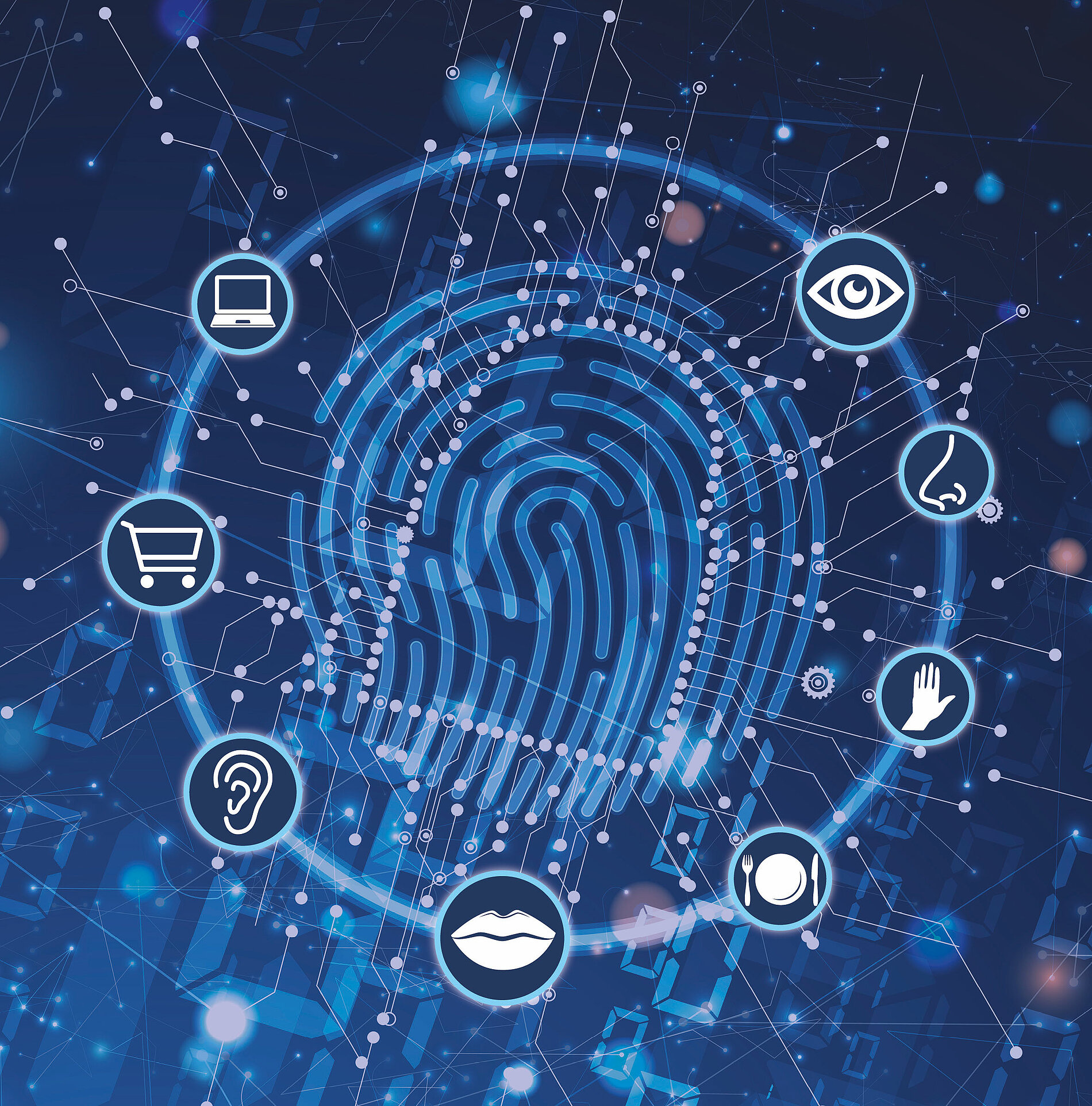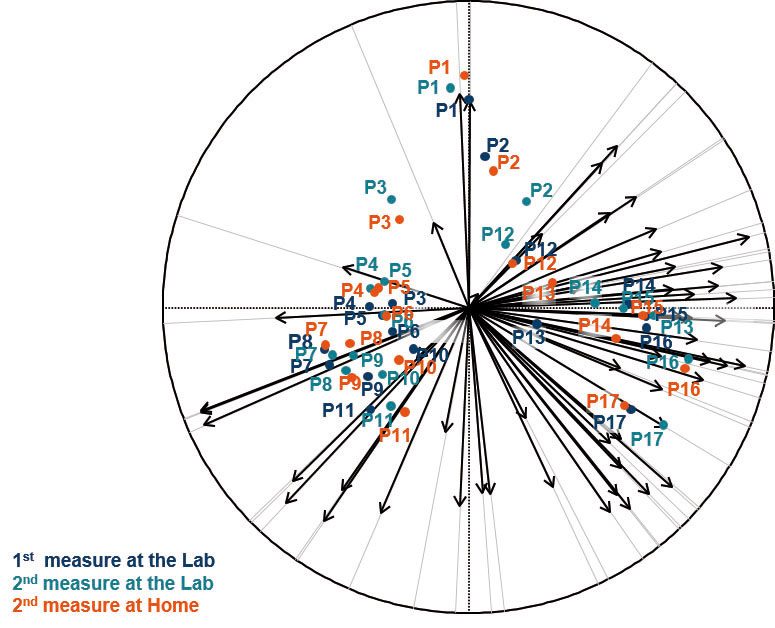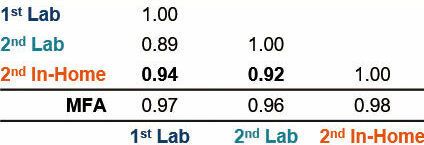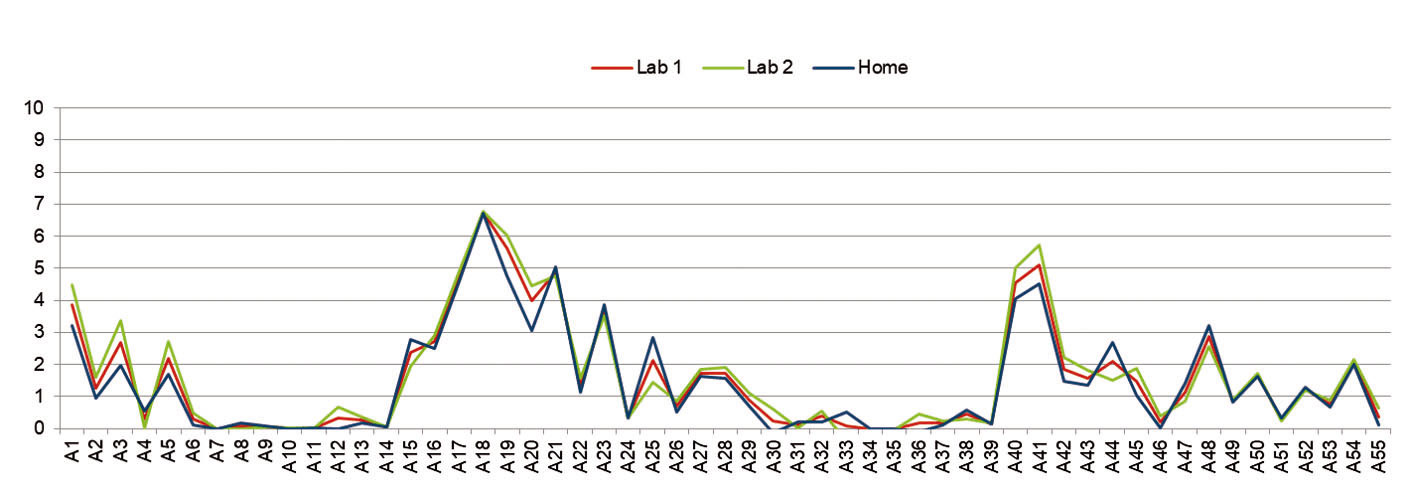Sensory evaluation: Contact-free, digital and online
DLG Expert report 4-2020
Recommendations and opportunities for sensory assessment with limited routine operation
Authors:
- DLG Expert Committee for Sensory Evaluation
- Working group: Annette Bongartz, Anna Fenkes, Bettina Krämer, Bianca Schneider-Häder
- Annika Ipsen, Senior Sensory Professional, isi GmbH, Göttingen, annika.ipsen@isi-goettingen.de
Contact:
- Bianca Schneider-Häder, DLG Competence Center Food Business, B.Schneider@DLG.org
Contents
- 1. Background
- 2. Goal
- 3. Use the crisis as an opportunity
- 3.1 Low-contact testing
- 3.2 Well thought-through sample management
- 3.3 Digital transmission of test results
- 3.4 Web-based panel training and tester management
- 4. Case example of sensory profiling: Comparison of laboratory data and in-home results
- 5. Conclusion
1. Background
The companies of the food industry are considered to be system-relevant. This means that even in crisis periods, food production is maintained while taking the necessary health protection into account, therefore ensuring the supply of the population.
In special situations, e.g. the corona pandemic, the crisis and/or emergency plans of the respective companies become effective. In addition to the continued strict compliance with or tightening of applicable hygiene specifications on the company grounds, this is especially linked to the reduction of personal contacts of the personnel working at the production site.
In the process, expert and management staff are frequently divided into fixed teams which – without mutual personal contact – work the production shifts and carry out system-relevant activities in alternation. Administrative staff and personnel not urgently needed for maintaining production locally is sent to work at home, on holidays or on leave to reduce overtime hours. As a result, in many places the activities of the sensory analysts for measures to ensure product quality, such as raw material inspections, process inspections and final product inspections, are reduced. In addition, projects such as product development, shelf-life and product stability tests, comparisons with the competition, etc. are at first suspended. Consequently, the usual panel work with consumers (hedonics) and with experts (descriptive and discriminating analytics) come to a standstill.
However, crisis periods also offer potential for alternatives. For example, lengthy decision-making processes frequently run more quickly under pressure and the courage to try something new also yields to misgivings. This is not only true for politics and the population, but also for several areas of the economy and food processing.
2. Goal
Initial ideas and experience have been compiled in the following. They are primarily intended as an aid for experts and management staff in the sensory evaluation sector, e.g. especially panel leaders in quality assurance and product development, when resuming their projects in the area of analytical (and if necessary also hedonic) sensory work. The first collection of practicable starting points and the intelligent use of digitalisation open up new potentials for human sensory assessment, which will continue to offer valuable opportunities for the practical use of sensory methods even beyond times of crisis.
3. Use the crisis as an opportunity
After crisis situations, especially sensory evaluation departments with their usually limited financial and personnel resources are faced with enormous challenges for continuing projects they have begun and launching new ones. This particularly applies when the basic operating conditions, and with them the daily working activities, continue to be determined by the crisis mode.
As a result, the following scenarios are sustained and consequently also relevant in the mid-term:
a) Strict compliance with defined hygiene regulations
On the part of the hygiene requirements, the following generally applies to all persons in the sensory evaluation area, especially those concerned with sample preparation and sample management:
- Thorough, regular hand-washing (at least 20 sec.) with soap and subsequent disinfection and, if necessary, wearing of disposable gloves.
- In addition to laboratory clothing and head coverings, wearing of mouth/nose protection and avoidance of contact of the hands with the eyes, nose and mouth.
- Compliance with the „coughing and sneezing etiquette“ (crook of the arm).
- Avoidance of unnecessary work interruptions, which make it necessary to wash and disinfect hands – if necessary also when changing gloves/clothes – nor any disturbance from working colleagues in this regard.
- Cleaning and disinfection of rooms, equipment (PC keyboards, etc.) and surfaces in the rooms to be used for tasting or in the sensory laboratory.
- Use of disposable dishes (plastic cups, cutlery, etc.).
- Ensuring of personal working distances of 1.5–2 m.
b) Limited personal contact and task backlog
With contact locks of employees and/or employee teams, and possibly consequently clearly defined „person-specific movement zones“ in the company, sensory training and joint tastings both by employees of different departments and by persons not belonging to the company – and possibly also consumers in the central sensory laboratory under standardised conditions – can no longer be readily realised. This results in task backlogs and many upcoming sensory projects cannot be processed and questions cannot be answered.
However, taste continues to be a major quality characteristic and purchasing criterion for food for many consumers. And for skilled staff, sensory methods are an indispensable screening instrument in process monitoring. Human sensory evaluation therefore remains an important scientific discipline both in market research and product development, as well as in quality assurance including monitoring of food safety and food fraud.
In addition to the advancing digitalisation, sensory analysis with expert panels currently also benefits from the experiences from sensory market research, and here particularly from the area of home use tests (HUTs). For especially with the latter process, the sensory test is carried out by consumers individually and in a home environment.
If these aspects are also applied to the analytical sensory assessment, new potentials are opened up so that – despite the reduction of personal contacts – professional work in sensory evaluation can be continued until the situation is „normalised“ and then, if necessary, physical meetings are also once again permitted. This refers both to sensory projects on all aspects of product quality and product development and to tester and panel training. For the uninterrupted continuation of sensory tests – even if in an altered form – should take place against the background that this can be used to continue training of the testers using the sample material in order to maintain, further develop and/or broaden their sensory competences and the required level of performance.
A more intensive conceptional preparation, clear test instructions, a professional, well thought-out sample logistics, digital transmission of test results and virtual tester meetings and/or video conferences moderated by the panel leader are the criteria for success for low-contact sensory tests and panel training. Even though with a decentralised tasting it must be initially assumed that the standardised environmental conditions otherwise usual for a laboratory test cannot be completely complied with, one should take advantage of the opportunities available and continuously monitor the extent to which this criterion has a negative impact on the test results.
Ideally, an attempt is made to successively optimise the situation so that the establishment of the decentralised testing workplaces can be largely uniformly designed with the aid of defined specifications. If, as an alternative to the sensory laboratory, not only home test stations, but also offices or meeting rooms at the company can be used for a limited time, the environmental conditions (in particular lighting conditions, room temperature, humidity and possibly sample temperature) should also be optimised according to this standard in the mid-term.
With the measures described in the following, ways to conduct sensory tests and training are shown which can also especially be implemented even during and after crisis situations with a health risk and restricted routine operation:
3.1 Low-contact testing
Basically, the following test forms can be distinguished with regard to the method:
a) Central tasting in sensory laboratory with separate test cabins
If a sensory test can still be carried out in the sensory laboratory or in the sensory room with separate test cabins and existing sample pass-through flaps or with testing tables, the procedure must be modified as follows:
- The number of testers present simultaneously must be reduced and ideally cut in half so that the distance between the persons in the test room can be increased in accordance with the hygiene requirements. In the process, only persons who come from one department or are assigned to a defined work team will be invited together.
- Here compliance with the hygienic requirements by all employees (hand hygiene and, if necessary, use of disposable gloves and mouth/nose protection) and the thorough cleaning and disinfection of the test cabins/tables and the digital input devices (e.g. keyboards, tablet screens) when changing testers including sufficient ventilation is also decisive.
- As a result, the total time requirement increases per test project, which in particular must be taken into account with regard to the time estimate until presentation of the test results (lower number of testers present simultaneously, more test meetings held consecutively, additional cleaning and disinfection).
b) Decentralised tasting in offices, at home (home test stations) or in meeting rooms reserved for tasting purposes
If strict zones are defined on the company grounds which prevent visiting the central sensory laboratory or sensory room, tastings in the respective offices or in meeting rooms reserved for a limited time for sensory assessment purposes within the respective zone are possible alternatives in this framework. In addition, tastings at home at the home test station would be an option.
With regard to this, two test variants can be distinguished:
- Asynchron ous individual test (offline individual test)
During this, the sensory assessment is carried out by the panelists independent of time and offline in the respective decentralised rooms (office, meeting room, at home at the home test station), whereby a defined time frame within which the test results must be determined is specified. This procedure is well-suited for difference tests. But this method is only conditionally suitable for descriptive tests and consensus profiling and only when the testers are experienced and the descriptors to be tested are familiar or have already been trained.
Remarks: During consensus tests, the individual test results must be combined to a group result so that following the on-site individual test, a joint discussion must be conducted which, if necessary, could be carried out via a virtual exchange, e.g. with a video conference. The same applies to panel training, if an exchange of experience follows the offline individual test on a digital level. - Synchronous individual test (online individual test)
This possibility for simultaneous tasting by the testers is suitable for both difference and for descriptive tests (including profile tests). Here the testers taste the samples individually in the respective decentralised rooms and document their test results there. Contact with the panel leader and the other testers is carried out via digital video conference systems, e.g. Skype, Microsoft Messenger, Teams, Zoom, Gotomeeting etc.
Questions can be asked in advance and, if necessary, after the individual sensory analysis a discussion and a subsequent consensus assessment is possible. In this case, a discussion of possible descriptors for a descriptive test is also possible in this case before the actual sensory test.
Ideally, a simultaneous and digital acquisition of the sensory test results would be possible for the sensory assessment itself but also for panel training purposes, e.g. by means of Limesurvey, Surveymonkey or optimally via sensory-specific tools like Red Jade, etc. Because in this way, the results could be presented immediately after the end of the individual sensory assessment and they could be available as the data basis for a subsequent panel discussion.
Both variants also require a clear, written briefing of the testers with regard to behaviour before the test (including no smoking, no coffee, no perfume 1–2 hours beforehand and hygiene rules, etc.). In addition, a renewed awareness with regard to behaviour during the sensory test should be carried out, e.g. with regard to quiet behaviour, concentration, regular neutralisation of the senses, etc., and with reference to the spatial environmental conditions to be ideally complied with (including a sufficiently large test station/table area for samples, testing and neutralising agents, as well as an odourless room, natural lighting conditions, etc.). The instructions before the test are important for minimising the possible negative influencing factors which result from the sensory assessment being conducted outside the standardised laboratory conditions. In view of sample handling as well, a clear briefing should take place beforehand in order to exclude standing times of different lengths before the tasting which would possibly result in a change of the tasting temperature, of the appearance due to surface drying or phase separation, etc.
3.2 Well thought-through sample management
Altered test conditions and the use of several decentralised testing locations place modified requirements on sample preparation and the sample logistics which are described in the following.
a) Sample preparation
- An important basis for reliable test results in analytical sensory assessment is still a professional, standardised preparation (blinding, coding, portioning, etc.) of the samples, which is carried out as up until now in the laboratory under defined hygiene standards (personnel, room) in accordance with „Good sensory assessment practice“, and therefore isolated from the panellists and testers.
- If possible, the use of changing laboratory teams, which have no personal contact to each other, is advisable here so that the workflow is ensured in case of illness.
- Ideally, the test samples are already pre-portioned and each tester receives his/her individual sample package with the respective sample set(s). The samples must be accompanied, if necessary, by corresponding storage and handling instructions so that the retention of quality of the test samples is also ensured outside the sensory laboratory.
- If a pre-portioning of samples is not logistically possible and this part must take place at the test site and by the panelist himself/herself, the transmission of coded empty test containers and the blinded, originally packaged products is possible. Here the panelists must then also be notified of additional, exact portioning instructions, and if necessary also of preparation instructions.
NOTE: The more sample handling is delegated to the panelists, the greater the risk of error.
b) Sample transport
- When organising modified sensory assessments in the central sensory laboratory with sample pass-through flaps, the usual sample logistics remains the same.
- This is structured differently for decentralised sensory assessments, for here commissioning and proper packaging of the test samples and test sets (if necessary under compliance with the cooling chain) is required.
- The blinded and coded samples to be tested including the test equipment (spoons, etc.) and the food to be used (neutralising agents) for cleaning the oral cavity or for taste compensation must be put together individually. In addition, the respective sample sets must be marked in accordance with the sensory tests listed in the test plan.
- The sample packets are then delivered directly to the respective (internal) tester at the company or, for external testers, by post to the home or, as an alternative, to a central collection location (if necessary, within the defined zones) or via another contact-free option for sample collection by the panelist himself/herself.
3.3 Digital transmission of test results
When software programs are used for the documentation of the test results from sensory-analytical tests, it would be ideal if these could be accessed not only via the PCs and/or tablets in the central sensory laboratory, but also decentrally via the computer of the panellists or ideally web-based programs would be used (also see Point 3.1 b). Short to mid-term alternatives would be the use of digital or printed test forms, which are then scanned in and sent to the panel leader or the responsible project manager or stored in a defined server directory. Companies that have already digitalised their sensory assessment or use web and cloud-based software systems have the advantage that there are no media breaks and the merging of the individual results to the final test results including the statistical analyses is simplified and can take place quickly.
3.4 Web-based panel training and tester management
In order to carry out the panel management and the panel training as contact-free as possible, digitalisation and various web-based software tools offer valuable support. It is also important to structure the information and communication online, to maintain contact virtually and to exchange and share the digital contents and knowledge. Asynchronous and synchronous methods can be differentiated here.
a) Asynchronous training methods
These methods enable a self-controlled learning of theoretical contents and sensory methods through the provision of information independent of time as videos, e-learning modules and digital scripts. The insight into defined tasting sequences and methods is also possible around the clock, i.e. 24 hours a day. In addition to these theoretical training sequences, practical exercises can also be structured asynchronously, if – as previously described in Point 3.2 Sample management – samples to be tested including detailed instructions are sent and, after submitting the test results by the panelists and data evaluation, individual digital and/or web-based feedback is given by the panel leader.
b) Synchronous training methods
These options supplement the asynchronous methods by enabling simultaneous immediate communication, discussion and information at defined times via moderated discussion forums, chats, telephone and/or video conferences. Here knowledge is exchanged, questions are clarified and a concrete briefing with regard to a
test to be carried out can take place directly in the dialogue. As a result, panel training courses can be conducted and/or the knowledge imparted theoretically and asynchronously in advance can be discussed and deepened
with video conferences initiated and moderated by the panel leader or the person responsible for sensory assessment.
4. Case example of sensory profiling: Comparison of laboratory data and in-home results
An evaluation of isi GmbH in Göttingen, Germany, shows that sensory-analytical tests in the form of descriptive tests can also be conducted outside of standardised test environments (e.g. sensory laboratory). In this way comparable, significant results can also be achieved, if the previously named aspects are taken into account.
Milk products were described by a descriptive panel in a project period of 8 weeks. The panellists started with the 1st measurement and part of the 2nd measurement of a total of 17 samples in the sensory laboratory (centrally) and
continued their activity with regard to the 2nd measurement in an in-home test (IHT, decentralised home test stations) while the laboratory was closed in the course of the corona crisis. The focus of the qualification phase and the specification of the descriptors was therefore carried out in advance under the accustomed conditions, i.e. in the group discussion moderated by the panel leadership (face-to-face).
The results are shown in Figures 1–3. The PCA (main component analysis) in Figure 1 shows a good agreement of the 3 profiles (1st measurement in the laboratory, 2nd measurement in the laboratory, 3rd measurement IHT). The distances from the centre of the map are an average of 109 % for the 2nd laboratory measurement and for the 2nd test cycle in the IHT with an average of 103 % are not shorter than for the 1st measurement in the laboratory. As a result, the method of IHT profiling achieves good results comparable to a profiling in the sensory laboratory. This statement is supported by a look into the RV coefficients shown in Figure 2 (similarity coefficients from the Multiple Factor Analysis, MFA). The results from the 2nd test cycle, which was conducted in the IHT, show good agreement with the values achieved in the laboratory.
Both the random test positions (see Figures 1 and 2) and the detailed profile of the sensory properties of an exemplary product (Figure 3) show a high level of agreement between the in-lab and in-home data. The evaluation data of isi GmbH therefore impressively verify the possibilities which also result for analytical sensory assessment through in-home testing. Depending on the requirements of the client and the project order, in-home project work can then be continued even after reopening of the sensory laboratories. As a result, any in-home interference sources can be minimised as best as possible, however a high level of expertise is decisive when instructing the panellists, during sample preparation and for the further project-relevant processes.
5. Conclusion
It is decisive for the previously described alternative options in analytical (and possibly also hedonic) sensory assessment that at first investments in the provision of the digital technology, in logistics concepts and in personnel time resources result. Initially because of the transition phase of the sensory assessment process there might be a higher planning expense required by the person responsible for the sensory evaluation.
This concerns both the detailed test planning including an extensive description of the test order and specifications, handling of the samples by the panellists and planning of the sample logistics. Furthermore, digitally supported panel management and tester training must be thought through in detail in order, for example, to skilfully and expediently combine elements of asynchronous self-study and the synchronous exchange of digital information and experience in training courses. In addition, the more demanding hygiene requirements for the personnel involved and the test rooms must be planned and implemented.
Facing the restricted routine operation in food sensory assessment using digital tools, reduced-contact test concepts and well thought-through sample logistics has already proven itself in practice and offers valuable approaches for a respective company-specific implementation. The initial investments to be made here will pay off in the course of time. This enables ongoing sensory assessments to be maintained as far as possible, tester training in the sense of refresher courses to be carried out and the motivation of the existing testers to be retained, as their important work can now be continued.
This modified process can certainly be realised more easily with panelists, who are already experienced and well trained in order to achieve the usual constant high level of agreement for the assessments, and therefore a high quality of test results. In addition, the type of product group to be tested has an influence that is not to be underestimated. This makes it necessary to verify and validate the results of the respective sensory projects accordingly in each case, especially under the modified conditions.
However, the options named previously can also open up the implementation of new panels, although this is initially more difficult if the persons recruited contact-free have had no experience whatsoever with sensory tests up until now. Yet with creativity and training goals which are at first not set all too high and test samples which are not too complex, this is certainly also possible in order to continue and/or conduct projects in the sensory area – especially in times of crisis. Ideas for this are, for example, available in the DLG Expert Knowledge on tester and panel training free of charge on the web. Moreover, further potentials will result in this modified daily work routine, which will help all persons responsible for sensory assessment to use the crisis as an opportunity and to professionally and expediently integrate the methods of sensory assessment of food. This will enable the taste of consumers to be met reliably and the contribution of the sensory assessors for ensuring the competitiveness of the company to be made. And although „contact-free“ sensory assessment is unaccustomed as part of training courses and when conducting tests, although it may appear difficult in practical terms and is certainly also not possible for all tasks, several of the previously named elements are a valuable investment in the digital future of the sensory evaluation by panelists. In addition, they offer the potential for supporting the effectiveness of sensory evaluations, even after crisis periods.
Contact:
Bianca Schneider-Häder, DLG Competence Center Food Business, B.Schneider@DLG.org





